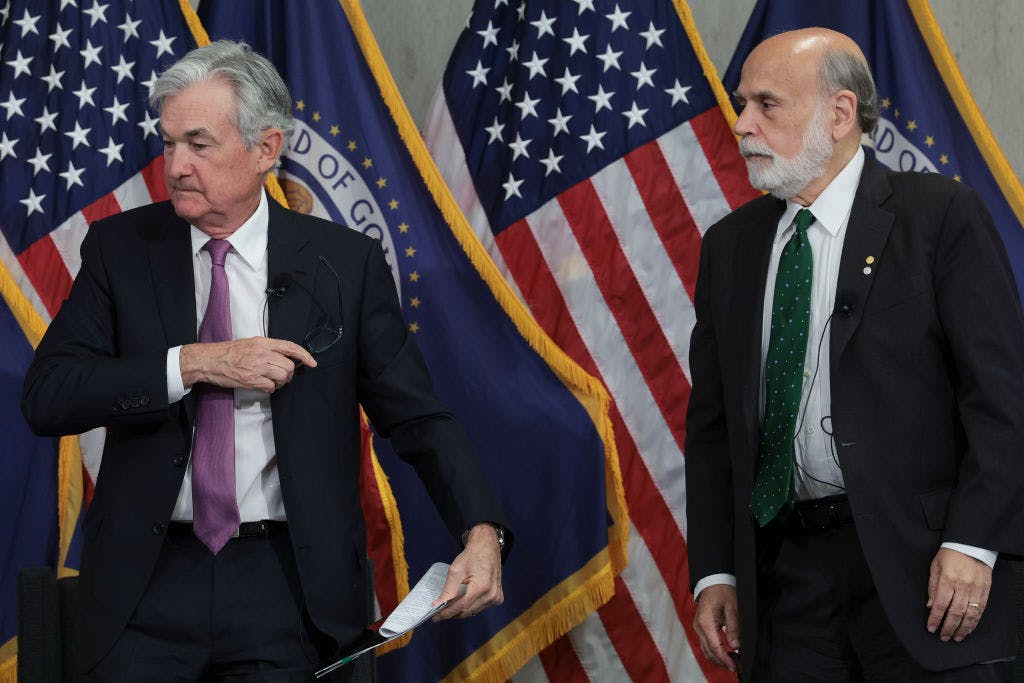The Federal Reserve’s Promised Land
‘We will not allow inflation to rise above two percent or less,’ Ben Bernanke burbled, declaring a confidence level of ‘one hundred percent.’

It could be to the Federal Reserve’s credit that the central bank hasn’t rushed to cut interest rates. After all, the Times’ Paul Krugman is trying to palm off on his noble readers the idea that “the war on inflation is more or less over, and we won.” Yet if federal debt and overspending are two triggers of today’s stubborn inflation, the Fed itself bears responsibility for another root cause of price increases — the central bank’s Quantitative Easing scheme.
This masterpiece of monetary manipulation led the Fed to inflate its balance sheet to some $9 trillion from less than $1 trillion before the 2008 crisis. It now stands at some 7.5 trillion spondulix. Critics decried the program for risking inflation and creating an asset bubble. The Fed originally described it as a “temporary” expedient. Chairman Bernanke defended the scheme, boasting on television that, if he had to, he could raise interest rates in 15 minutes.
“Many people believe that could be highly inflationary,” CBS News’ Scott Pelley observed of Mr. Bernanke’s asset purchase scheme. “That it’s a dangerous thing to try.” The Fed chairman would have none of it. “Well, this fear of inflation, I think is way overstated,” he crooned. “We’ve looked at it very, very carefully” and “analyzed it every which way.” The only “trick,” he said, was “to find the appropriate moment when to begin to unwind this policy.”
At the time, the Fed’s balance sheet stood at some $2.4 trillion, itself a radical expansion. Yet by the time Mr. Bernanke stepped down as chairman, it hadn’t fallen, but risen, to some $4 trillion. When Mr. Bernanke, in 2013, tried to dial down the Fed’s balance sheet, it sparked what Reuters called a “taper tantrum” — “a wave of panic, volatility and uncertainty.” Later, Covid prompted more growth in the balance sheet, bringing it up to, by 2022, nearly $9 trillion.
Since then, the Fed has been slowly running down its balance sheet by letting assets “run off” when they reach maturity. That’s knocked off about a trillion. Mr. Bernanke’s successor, Jerome Powell, says he will soon announce the Fed’s plans to scale back the pace of this run-off. A New York Fed official, Julie Remache, warned in February that “a return to the $4.2 trillion pre-Covid balance sheet is very unlikely.”
That bloated balance sheet, though, was already some four times higher than the Fed’s historic level. The recent jump in interest rates has now pushed the central bank into technical insolvency. Mr. Bernanke’s asset binge sought to stimulate the economy by acquiring long-term bonds that pushed down interest rates. With rates now higher, the Fed is paying more in interest on the deposits in its, so to speak, vaults than the central bank earns on its portfolio.
What’s stopping the Fed from returning to the pre-Bernanke norm? It doesn’t want to trigger another “tantrum.” Neither does it seek a crisis of balance sheets for businesses that borrowed not wisely but too well in response to a dozen years of the Fed’s pygmy interest rates. Historically, a 5 percent borrowing cost is no higher than average. Today, it is sorely testing the banks and leveraged firms that took the Fed at its word that zero percent rates were here to stay.
Which brings us back to Mr. Bernanke. When he began the balance sheet expansion he assured Americans that “we will not allow inflation to rise above two percent or less,” with a confidence level of “one hundred percent.” Call it the Fed’s promised land. Now, the Fed warns that “recent trends point to a sizable balance sheet in the long run.” It is having a dickens of a time getting inflation back down to 2 percent — owing to its own monetary manipulations.

